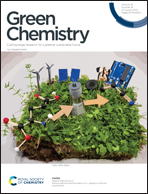Highly efficient production and purification of fructose via glucose isomerization by calcium chloride and triethylamine†
Abstract
As a renewable source, fructose is of great significance in biomass conversion and food industries. Currently, most of the chemo-catalysts studied, with glucose as a substrate, are limited by the thermodynamic equilibrium of the reaction, resulting in the maximum yield of fructose of approximately 30–40%. The similar chemical structures and physical properties of monosaccharides bring another challenge for the separation of fructose from the reaction mixture. In this study, the combination of CaCl2 and Et3N was found to alter the thermodynamic equilibrium and promote fructose separation. The reaction parameters were optimized and up to 78% fructose yield could be obtained. The pathways of the isomerization reaction were found to involve both intramolecular hydride shift and an enediol intermediate mechanism, and the former was major. It could be speculated reasonably that Ca2+ played a key role in glucose conversion and interacted with glucose at its C1 and C2 positions, and Et3N interacted with Cl− while providing an alkaline environment. The formation of the α-fructofuranose’ complex, from Et3N, CaCl2 and α-fructofuranose, could shift the equilibrium of glucose isomerization towards fructose formation. According to the diffusion-ordered spectroscopy (DOSY) NMR results, the strong complexation slowed down the diffusion rate of the α-fructofuranose’ complex, allowing it to gradually precipitate, and hence drove the reaction equilibrium towards the desired fructose. The precipitate was filtered from the reaction mixture and processed further to obtain high-purity fructose in 45% isolated yield. Moreover, the filtrate containing solvent and reagents obtained in the separation process could be recycled.



 Please wait while we load your content...
Please wait while we load your content...